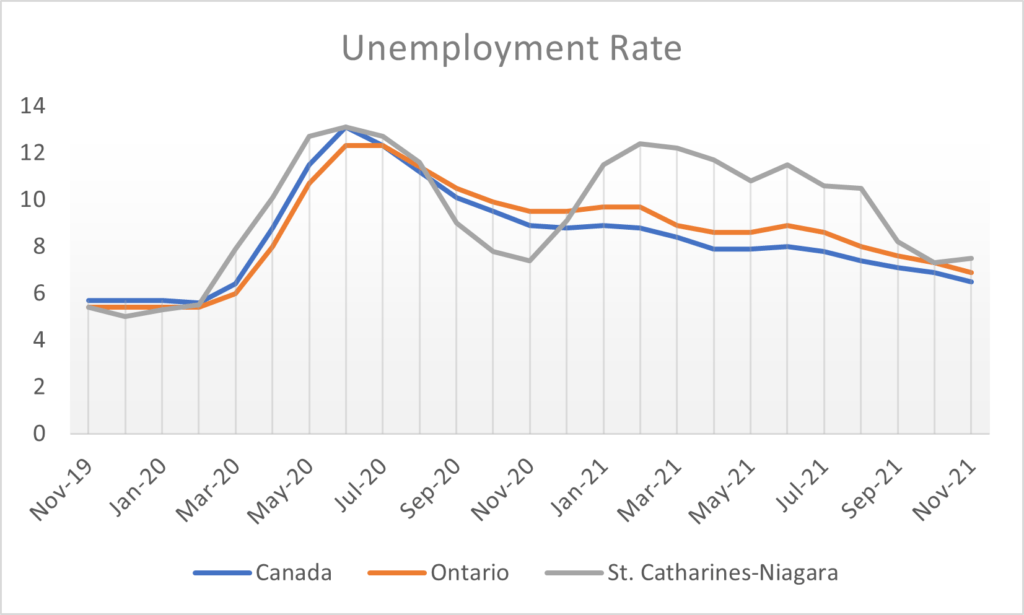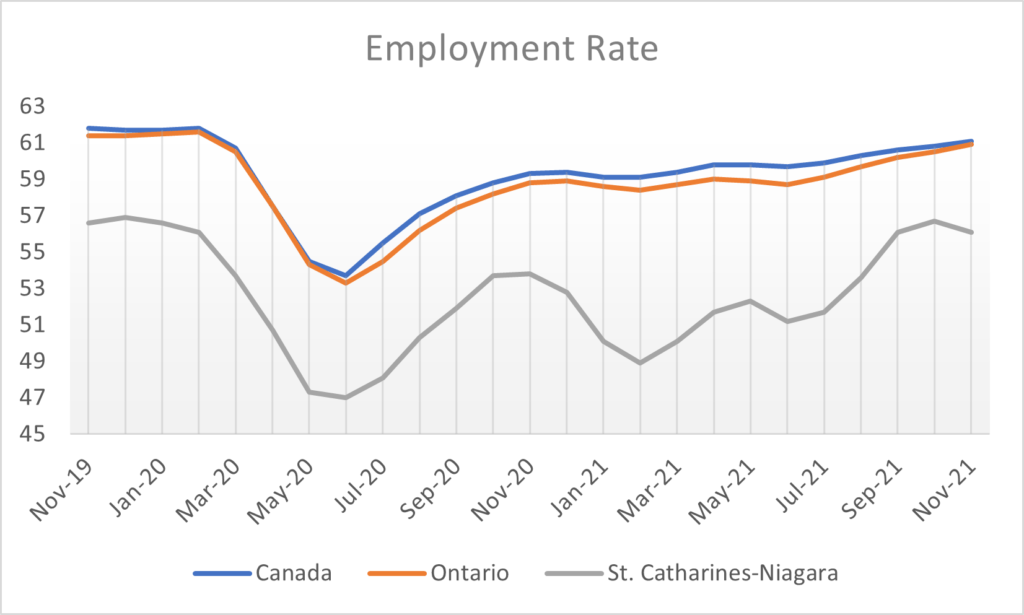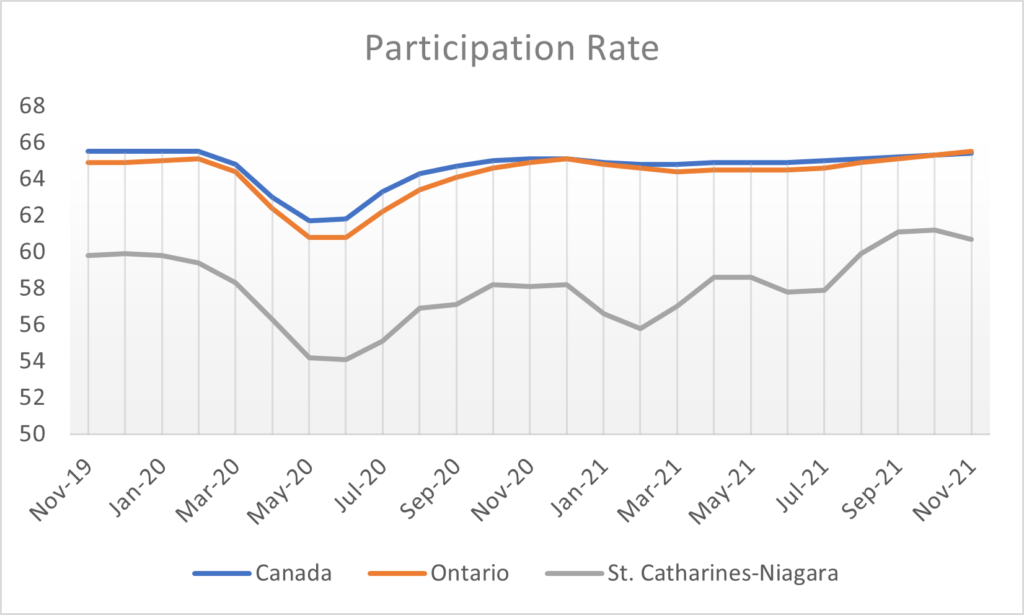Niagara unemployment ticks upward in November
Niagara’s unemployment rate crept up from 7.3% in October to 7.5% this November, bucking downward trends in Canada (6.9% to 6.5%) and Ontario (7.3% to 6.9%). The data are seasonally adjusted. After a bad year, Niagara unemployment had returned to the provincial level by last month. It remains to be seen whether this month is an anomaly or an indication that Niagara’s unemployment rate will creep upward again over the winter. Although many Niagara businesses report difficulty in hiring staff, it should also be noted that winter is traditionally the slow period for accommodation, agriculture, and the tourism sector.
The current unemployment rate is slightly higher than that in November 2020 (7.4%), although the participation rate increased from last year as more people returned to the workforce. Labour market participation rates in Niagara remain consistently below the province and the country, owing in large part to Niagara’s substantial student and retiree population.
Data are taken from Statistics Canada’s Labour Force Survey.
Canada adds 154,000 jobs in November
Employment rose by 154,000 (+0.8%) in November and was 186,000 (+1.0%) higher than its pre-COVID February 2020 level. The unemployment rate fell to 6.0%, within 0.3 percentage points of what it was in February 2020.
Employment increased in both the services-producing and goods-producing sectors in November. Both full-time (+80,000; +0.5%) and part-time (+74,000; +2.1%) work increased, and employment gains were spread across six provinces.
Total hours worked increased 0.7% and returned to the pre-pandemic February 2020 level for the first time. Hours rose across most industries, led by manufacturing, wholesale and retail trade, as well as construction. Despite increasing in November, hours in the goods-producing sector were still below their pre-pandemic level (-3.6%). All of the growth compared with February 2020 was in the services-producing sector (+1.3%), most notably in professional scientific and technical services (+12.5%).
Click here for more information.
Labour Force Survey: Interactive
Labour Market News Roundup
Reuters noted the large and unexpected job numbers gains posted today, but added that it was unlikely to change the Bank of Canada’s guidance amid worries over a new coronavirus variant. “I think the job market is tighter than the Bank of Canada has been letting on,” said Derek Holt, vice president of capital market economics at Scotiabank, pointing to wages gains, which accelerated to 3.0% on the year from 2.1% in October.
CBC News struck an optimistic note, observing that the jobless rate was now at a pandemic low of 6%, and that 183,000 more people are working now than before the pandemic. Wages have risen 7.7% over two years as the number of people making less than $12 an hour has fallen dramatically over the past two years, from more than a quarter of a million people before to just 165,000 people today. The number of long-term unemployed had its biggest drop since the pandemic started in November, plunging by 62,000 people to 305,000 people, down from a peak of 510,000 in April.
CTV News examined the female labour market in more detail. Their story highlighted that the share of core-age women with a job was the highest since 1976, which Jennifer Robson, associate professor of political management at Carleton University, was quoted as saying could have been helped by more mothers working with schools and daycares open.
The Financial Post was bullish on the labour market, stating that it “blew past expectations” and that the numbers should buoy confidence in Canada’s recovery, since both the increase in hiring and the outsized drop in the jobless rate far exceeded the expectations of private forecasters. The Bay Street consensus ahead of Statistics Canada’s latest report on the labour market was for an increase of about 40,000 jobs and an unemployment rate of about 6.5 per cent. The loonie surged half a cent in a matter of seconds after the hiring numbers were released at 8.30 a.m., the Post said, as traders compared the Canadian data with disappointing figures coming from the United States, where employers added 210,000 positions in November, less than half of what Wall Street had been expecting.
BNN Bloomberg was also optimistic, calling the national economy “close… to full employment at a time when businesses are raising worries about labor shortages and policy makers are considering ways to cool the recovery down.” Bloomberg coupled rising wages with a separation rate – the share of employed Canadians who enter the unemployment ranks – that was the lowest since records began in 1976 as an indication of how tight the labour market was getting, and how keen employers were to retain talent. The outlet cautioned that these data would only support the hypothesis that interest rates would be hiked in 2022, however.
The Globe and Mail echoed this concern, making speculation that the job gains would accelerate a rate hike their headline. Several analysts, the newspaper commented, said the Bank of Canada may be forced to raise its key lending rate – now at a record low of 0.25 per cent – sooner than previously expected.
“Given tighter labour market conditions, stronger price pressures, and hot housing market activity, we can’t discount the possibility the Bank may choose to hike as early as January,” said Sri Thanabalasingam, senior economist at Toronto-Dominion Bank, in a note.
Reading Recommendations
The Omicron Variant: How Companies Should Respond
Harvard Business Review
The emergence of the Omicron variant of Covid-19 has dimmed hopes that the pandemic will soon fade away and once again has employers pondering how they can fulfill their difficult obligations to keep their workforce safe and to meet their business needs.
The good news is that as the virus has evolved, employers have honed their strategies to keep infections in check. By continuing to be creative, flexible, and adaptive in their approaches, they can contain the threat now and handle other outbreaks if other variants arise — a significant possibility given the low levels of vaccinations in many parts of the world, including some areas of the United States. Here are some broad measures they can apply.
Niagara COVID-19 statistics tracker
Niagara COVID vaccination tracker
Free rapid COVID-19 testing kits are now available to businesses. Visit gncc.ca/workplace-self-screening-kits to learn more and reserve kits for your organization.
Information on government grants, resources, and programs, policies, forms, and posters for download and use, are available here. The GNCC is here to support you. Contact us with any questions you have.
Through the Daily Updates, the GNCC aims to deliver important business news in a timely manner. We disseminate all news and information we feel will be important to businesses. Inclusion in the Daily Update is not an endorsement by the GNCC.






